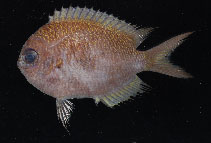| Family: |
Pomacentridae (Damselfishes), subfamily: Chrominae |
| Max. size: |
6.85 cm SL (male/unsexed) |
| Environment: |
reef-associated; marine; depth range 42 - 120 m |
| Distribution: |
Western Pacific: Marshall Islands southward to Fiji, across the Caroline Islands from Puluwat to Palau, and south to Vanuatu. This species was not observed at Rarotonga (Cook Islands), Kiritimati (Line Islands), nor in American Samoa during brief surveys of deep reefs in these areas. |
| Diagnosis: |
Dorsal spines (total): 13-13; Dorsal soft rays (total): 13-14; Anal spines: 2-2; Anal soft rays: 15-16. This species is distinguished by the following characters: Dorsal rays XIII,13-14, usually 14; anal rays II,15-16; pectoral rays 18-19, usually 19; spiniform caudal rays 2-3, usually 3; tubed lateral-line scales 14-16; gill rakers 6-8 + 19-22 (usually 6-7 + 19-21; total 26-29); body depth 1.57-1.77 in SL. Color when fresh is pale lavender-tinged gray dorsally, paler ventrally; 3 or 4 rows of scales dorsally from nape to upper caudal peduncle with gold edges; small scales on basal sheath of dorsal fin almost entirely gold; median fin membranes lavender gray or translucent blue, suffused with gold color; iris yellow (Ref. 59379). |
| Biology: |
Adults are generally abundant in their usual environment, steep slopes and drop-offs at depths of about 90-120 m; usually with small holes and limestone talus, often in aggregations ranging from 6 to several dozen individuals seen feeding low in the water column (Ref. 59379). Oviparous, distinct pairing during breeding (Ref. 205). Eggs are demersal and adhere to the substrate (Ref. 205). Males guard and aerate the eggs (Ref. 205). Minimum range from Ref. 82433, where this species was found together with Chromis unipa. |
| IUCN Red List Status: |
Not Evaluated (N.E.) Ref. (130435)
|
| Threat to humans: |
harmless |
Source and more info: www.fishbase.org. For personal, classroom, and other internal use only. Not for publication.
